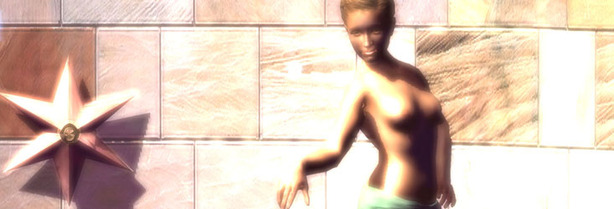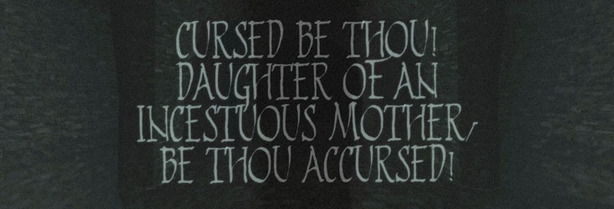
Fatal Flaws of Fatale
The problem that Fatale inherently faces is that it doesn’t seem to translate the message it seems to be trying to tell into an actual activity for the player to do. That in itself is fine – Dear Esther already showed us that we can be content to simply wander through an ambience – but Fatale falls down because it tries to introduce these interactions anyway.The first part of the game, which is set in a small underground cistern and sees you controlling John the Baptist in the moments leading to his execution, is a strong opening for the game. You wander around the tiny room, reading passages that are scrawled on the walls and quotes from Oscar Wilde’s Salome as they float in the air, while a patchwork of veils extends across the bottom of the screen.
It’s a baffling opening to those who aren’t up on their biblical verse, but to those who are the setting is quite clear. The timeline at the bottom is the Dance of Seven Veils and when it comes to an end then so will you. The tension is heightened and made palpable by the claustrophobia and soft, serene music.
When you switch to the second part of the game though, which is simply of Salome on the terrace above, with the head nearby and her mother watching rigidly, the structure starts to tumble. The aim here is to float through the scene using deliberately clunky and constrictive controls to extinguish all the lights around you – an interaction which, if I’m honest, seems purposeless and at odds with everything else.
Worse, it’s an idea which isn’t introduced anywhere and, because the controls are totally different to other parts of the game/not-game, you have to look it all up in the main menu. The start of Fatale creates a simple and wonderfully effective feeling of confusion and dread, then the next stage completely shatters it. Instead, it replaces it with pure tedium as you have to slowly extinguish about twenty lights, one by one. It takes ages and when it’s over, so is the game. Although you can boot it back up for a third section where you, as Herod, watch Salome perform her dance, there isn’t much more to do after that and all you can do is watch.
Honestly, though we adore the music and concept of Fatale, we’re not sure it’s worth pushing through the second stage of the game since it never manages to out-do its own opening sequence. It quickly progresses from great to grating and, though that can be a useful idea for some art, it isn’t appreciated here.
It’s at this point where I fall into a bit of a quandary. On the one hand, Fatale clearly isn’t a game, it’s a piece of interactive art. On the other hand, though the art itself is striking and interesting to some extent, the actual interactive element is limited and brief and, frankly, annoying. I’ve also got to balance out the fact that I believe what Tale of Tales is doing with interactive art is important and should be encouraged, even if Fatale isn’t a very good example.
As was previously established with The Path though, I’m not an art critic and I do have to give a score which I feel reflects the product – asinine as that is. In this case, Fatale just doesn’t feel as visually or tonally unique as some other games out there and, whereas the controls and barriers established in The Path felt
 like obstacles to be appreciated and overcome, those in Fatale feel like they need to be endured.
like obstacles to be appreciated and overcome, those in Fatale feel like they need to be endured.Maybe I’m missing something and that’s kind of the point of it all – it’s actually likely that I’ve overlooked a motif or idea that would string Fatale together into something essential and worthwhile. If that’s an idea that interests you and you’re the type of person who likes experimenting with these concepts and emotions then you should definitely disregard this review and buy a copy of Fatale right now – because it will offer you things you can’t get anywhere else. I know; I’ve wallowed in them.
If you’re at all interested in value for money and other things of that type then it’s probably best to let Fatale pass you by though. Unlike with The Path I didn’t feel compelled to stay with it longer than I had to and, now that it’s done, I doubt I’ll return to it. It’s the type of artwork you’d like to see in a museum once – not something you need to take home with you and put on the wall.
Score Guide

MSI MPG Velox 100R Chassis Review
October 14 2021 | 15:04











Want to comment? Please log in.